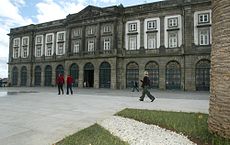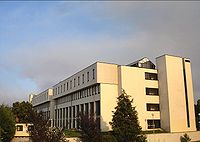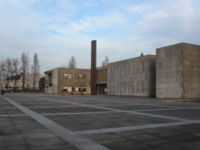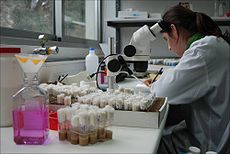- University of Porto
-
University of Porto Universidade do Porto 
Motto Virtus Unita Fortius Agit Established 1911 Type Public University Rector José Carlos D. Marques dos Santos Admin. staff Teaching Staff: 1 920 (ETI) / Technical and Administrative Staff: 1 693 Students 30,640 (2009)[1] Undergraduates 22 405 (1st Cycle and Integrated Master courses) Postgraduates 8 235 (Master and Doctorate courses) Other students 742 (Post-Doc) Location Porto, Portugal Website www.up.pt The University of Porto (Universidade do Porto) is a Portuguese public university located in Porto, and founded 22 March 1911. It is the largest Portuguese university by number of enrolled students and has one of the most noted research outputs in Portugal. It was considered one of the 100 best Universities of Europe, in 2010[citation needed].
Contents
History
The university results, essentially, from two higher education institutions created during the 19th century in Porto: the Politechnical Academy (Academia Politécnica) and the Medical-Surgical School (Escola Médico-Cirúrgica). After the 1910 revolution in Portugal, starting the First Republic, the Universities of Lisbon and Porto were created. Initially, the University of Porto was composed of three faculties:
- Faculty of Mathematical, Physics, Chemical, Historical and Natural Sciences (including the Engineering School)
- Medical-Surgical School (including the Pharmaceutical School)
- Faculty of Trade (never implemented)
The inauguration of the University of Porto was on July 16, 1911, and as first Reitor (rector), the mathematician Gomes Teixeira was chosen. At this time, the university became economically and scientifically independent, and teaching autonomy was officially recognised. Currently, there are 14 faculties and a postgraduate business school at the university.
Organization
Today, about 28,000 students (11,000 postgraduate) attend the courses provided by the U.Porto's fifteen schools (13 faculties, a biomedical sciences institute and a business school, each one with a considerable degree of autonomy).
- Faculty of Architecture, FAUP
- Faculty of Dental Medicine, FMDUP
- Faculty of Economics, FEP
- Faculty of Engineering, FEUP
- Faculty of Fine Arts, FBAUP
- Faculty of Law, FDUP
- Faculty of Arts, FLUP
- Faculty of Medicine, FMUP
- Faculty of Nutrition and Food Science , FCNAUP
- Faculty of Pharmacy, FFUP
- Faculty of Psychology and Educational Sciences, FPCEUP
- Faculty of Sciences, FCUP[1]
- Faculty of Sport, FADEUP
- Institute of Biomedical Sciences Abel Salazar, ICBAS
- Porto School of Management, EGP
Globally, the U. Porto offers 63 graduate degree courses, over 160 master courses, and several doctoral degree courses and other specialization courses, supported by 2300 lecturers and a technical and administrative staff of over 1600 people.
In 2007, a Higher Education Evaluation & Accreditation Council of Taiwan's ranking, placed the University of Porto in 459. It was the only Portuguese university in the top 500 according to the Taiwanese ranking.
R&D
R&D activities at the University of Porto have significantly expanded over the last years, mainly as a result of academic qualification and increased funding of R&D facilities and research grants through competitive programs with external independent evaluation by international peer review committees. Although R&D centers vary noticeably in dimension, aims and structure — from small units to large centers, conducting specialized or interdisciplinary work, faculty integrated or independent — they are present in almost every field of knowledge showing a shared vision towards a modern research university. Many of these centers are interface institutions whose aim is the development of links of cooperation between the University and external entities such as enterprises or governmental organizations. Among the most recognized research centers of the university are the IBMC - Instituto de Biologia Molecular e Celular (Institute of Molecular and Cell Biology), IPATIMUP - Instituto de Patologia e Imunologia Molecular da Universidade do Porto (Institute of Molecular Pathology and Immunology of the University of Porto) and INESC-Porto - Instituto de Engenharia de Sistemas e Computadores (Research Institute of Computer Systems).
Facilities
The University buildings — faculties, R&D centres, student residences and sport facilities — are grouped in three main sites (called ‘poles’). In the city centre — where the neoclassical building of architect Carlos Amarante marks the birthplace of the University — lies Pole 1; Pole 2 (Asprela) is a campus in the northern end of Porto; Pole 3 (Campo Alegre) is located in the western part of the city, over the river Douro bank, not far from Pole 1. A number of other institutes and centers are scattered all over the city and even beyond its limits.
The development of strong links with the community is one of the University's main concerns. This lies behind the constitution of the Foundation Science and Development, an institution which associates University and municipality and is responsible for the management of two important cultural facilities located in Pole 3: the Porto Planetarium and the Campo Alegre Theatre. Another evidence of this concern is the priority given to Continuing Education, with the development of multidisciplinary courses, the establishment of cooperation protocols, the training of teachers, the foundation of the Association of Portuguese Universities for Continuing Education and the providing of on-line courses.
International Cooperation
The University of Porto is deeply committed to the development of its international relations, taking part in several university networks and cooperation groups — not only within Europe but also extending to the southern hemisphere countries of Portuguese language. The increasing numbers of students taking part in mobility programs, the exchange of lecturers and researchers, the participation in international R&D projects and the involvement in cooperative projects with Brazil and several African countries are a reflection of the importance the University gives to its international orientation. This is why, every year, a growing number of students and scientists from all over the world choose the University of Porto as their preferred teaching and research institution. Just last year (2007), around 2.000 foreign students completed their higher education in the University of Porto.
Finally, one should mention the active role the University has played in international actions concerning the assessment and funding of higher education institutions, both fundamental to the development of Portuguese models in these areas.
Students
 Queima das Fitas student parade.
Queima das Fitas student parade.
The students of the University of Porto organise several extra curricular events. In sports, those include the activities promoted within G.A.D.U.P. and C.D.U.P.. In culture and academic festivities, the events range from the Latada to the Queima das Fitas. This last event is organized in cooperation with FAP - Federação Académica do Porto and it is considered the biggest party of the students in Porto.
Famous alumni and professors
- Abel Salazar, doctor, professor, painter.
- Agostinho da Silva, philosopher.
- António Carneiro, painter.
- António Pinho Vargas, pianist and composer.
- Alexandre Quintanilha, scientist.
- Anake Kijjoa, professor and scientist.
- António Soares dos Reis, sculptor.
- Artur Aguas, professor and scientist.
- Belmiro de Azevedo, businessperson.
- Camilo Castelo Branco, writer.
- Corino de Andrade, professor and scientist.
- Edgar Cardoso, civil engineer and professor.
- Eduardo Souto Moura, architect.
- Elisa Ferreira, politician.
- Fernando Teixeira dos Santos, minister.
- Francisco Laranjo, painter and professor.
- Froilano de Mello, microbiologist and MP in the Portuguese National Assembly.
- José Pacheco Pereira, teacher and political analyst.
- Júlio Dinis, doctor, writer.
- Kaúlza de Arriaga, Brigadier General, writer, professor and politician.
- Luís Archer, biologist, epistemologist and professor.
- Luís Prista, professor and scientist.
- Richard Zimler, professor and writer.
- Mário Sousa, professor and scientist.
- Nuno Grande, professor and scientist.
- Rómulo de Carvalho / António Gedeão, scientist and poet.
- Rui Reininho, musician.
- Rui Rio, politician and mayor of Porto.
- Sérgio Godinho, musician.
- Alvaro Siza, architect.
- Teresa Lago, astrophysicist and professor.
- Victor de Sá, historian and professor.
See more University of Porto Famous Alumni (Official page)
See also
- List of modern universities in Europe (1801–1945)
- List of universities in Portugal
- Higher education in Portugal
References
External links
Santander Network Aalborg University · Adam Mickiewicz University · Babeş-Bolyai University · Eindhoven University of Technology · Ghent University · Grenoble Institute of Technology · Joseph Fourier University · Lund University · Malmö University · Minho University · Norwegian University of Science and Technology · Pierre Mendès-France University · Polytechnic University of Valencia · Universidad Autónoma de Nuevo León · University of Bari · University of Bayreuth · University of Bergen · University of Cantabria · University of Catania · University of Giessen · University of Gothenburg · University of Las Palmas de Gran Canaria · University of Le Havre · University of Leeds · University of Liège · University of Limerick · University of Malta · University of Murcia · University of Osnabrück · University of Patras · University of Pau and Pays de l'Adour · University of Porto · University of Rennes 1 · University of Rennes 2 – Upper Brittany · University of Rouen · University of Southern Denmark · University of Trieste · University of Valladolid · University of Wrocław · Vrije Universiteit
Conference of European Schools for Advanced Engineering Education and Research Aalborg · Athens Polytechnic · BME · BUT · Chalmers · CTU Prague · DTU · École centrale Paris · EPFL · ETH Zurich · Florence · Ghent · GIT · Hanover · Heroit-Watt · INSA de Lyon · INSA de Toulouse · IST · ITU · Karlsruhe · KTH · KTU · KU Leuven · LTH · METU · NTNU · ParisTech · Politecnico di Milano · POLITO · Porto · PUB · Queen's · PUT · RWTH Aachen · Southampton · Stuttgart · Supélec · Technion · Thessaloniki · TKK · TPU · TU Berlin · TU Crete · TU Darmstadt · TU Delft · TU Dresden · TU Eindhoven · TU Hamburg · TU Ilmenau · TU Munich · TU Vienna · TU Warsaw · TUT · Twente · UCL · UCD · UPC · UPM · UPV
Public universities in Portugal Public universities: University of the Algarve • University of Aveiro • University of the Azores • University of Beira Interior • University of Coimbra • University of Évora • University of Lisbon • University of Madeira • University of Minho • New University of Lisbon • University of Porto • Technical University of Lisbon • University of Trás-os-Montes and Alto Douro
Public university institute: ISCTE - Lisbon University Institute
Distance public university: Universidade Aberta
Categories:- University of Porto
- Educational institutions established in 1911
- 1911 establishments in Portugal
Wikimedia Foundation. 2010.







